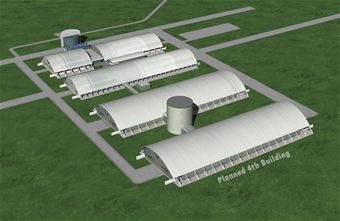
The National Museum of the U.S. Air Force is set to expand its legacy with a new 224,000-square-foot building to be constructed by Turner Construction Company of Washington, D.C.
The contract for the museum’s newest building, which will be similar in size and shape to its three existing hangars, was awarded by the U.S. Army Corps of Engineers, Louisville District, for $35.426 million, and is being privately financed by the Air Force Museum Foundation, a nonprofit organization chartered to assist in the development and expansion of the museum’s facilities.
Current plans call for construction to begin in late spring 2014 and be completed in the summer of 2015. The museum will then begin populating the building that fall. A public opening is anticipated in late 2015.
According to Museum Director Lt. Gen. (Ret.) Jack Hudson, the fourth building will provide more educational opportunities, increase visitor access to the presidential and research and development aircraft and improve visitor experience with space exhibits and large aircraft.
“We’re extremely excited about the fourth building because this new facility will help us to further tell the Air Force story with much needed exhibit space and also provide dedicated educational areas for programs based in science, technology, engineering and mathematics (STEM),” said Hudson. “There will be opportunities for visitors of all ages, but a special emphasis will be placed on programs that inspire and motivate our youth toward an Air Force or STEM career.”
The new climate-controlled building, with LEED 3.0 Silver certification, will house four major elements of the Air Force story.
The Presidential Aircraft Gallery will allow the museum to relocate and expand one of its most popular galleries, currently located on a controlled-access portion of Wright-Patterson Air Force Base and accessible by bus to a small percentage of museum visitors. The fourth building will provide all visitors the opportunity to view this historic collection of presidential aircraft, and walk through four of them, including aircraft used by Presidents Roosevelt, Truman and Eisenhower, as well as the Boeing VC-137C used by President Kennedy, also known as SAM (Special Air Mission) 26000 which carried his body back to Washington, D.C. from Dallas, Texas after his assassination on Nov. 22, 1963, and served as the location where President Lyndon B. Johnson was sworn in as the new president.
The Research and Development Gallery will also to be relocated from the base and offer visitors the opportunity to view the world’s only remaining XB-70 and other aerospace vehicles.
The new Space Gallery will showcase the Space Shuttle exhibit featuring NASA’s first Crew Compartment Trainer (CCT-1), a high-fidelity representation of a space shuttle crew station used primarily for on-orbit crew training and engineering evaluations. As a major exhibit component of that gallery, visitors will be able to walk onto a full-size representation of a NASA space shuttle payload bay and look inside the CCT-1 cockpit and mid-deck areas.
The Global Reach Gallery will give the opportunity to house large aircraft in the museum’s collection, such as the C-141 Hanoi Taxi, which airlifted the first American POWs to freedom from Hanoi, North Vietnam in 1973.
“It is vital for the Air Force to have the support of the American people, along with those from around the world,” Hudson said. “As the public’s window to the Air Force, more than 1 million visitors come to the museum each year, and another 3.5 million people visit online through the museum’s website and virtual tour to learn about the mission, history and evolving capabilities of America’s Air Force.”
The Air Force Museum Foundation recently gifted the funds necessary to begin construction of the building and will continue fundraising toward its campaign goal of $46 million, which would provide additional options and amenities for the building.
Rendering courtesy of National Museum of the United States Air Force Public Affairs.


 Join our thriving community of 70,000+ superintendents and trade professionals on LinkedIn!
Join our thriving community of 70,000+ superintendents and trade professionals on LinkedIn! Search our job board for your next opportunity, or post an opening within your company.
Search our job board for your next opportunity, or post an opening within your company. Subscribe to our monthly
Construction Superintendent eNewsletter and stay current.
Subscribe to our monthly
Construction Superintendent eNewsletter and stay current.